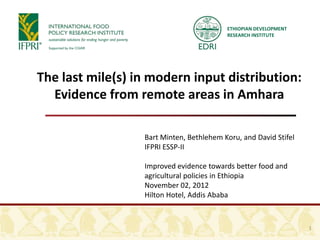
The last mile(s) in modern input distribution
- 1. ETHIOPIAN DEVELOPMENT RESEARCH INSTITUTE The last mile(s) in modern input distribution: Evidence from remote areas in Amhara Bart Minten, Bethlehem Koru, and David Stifel IFPRI ESSP-II Improved evidence towards better food and agricultural policies in Ethiopia November 02, 2012 Hilton Hotel, Addis Ababa 1
- 2. 1. Introduction • Most promising way of increasing agricultural productivity is through the adoption of modern inputs. • However, several constraints to adoption. Most importantly related to profitability issues and lack of familiarity of farmers with new technologies. • This paper looks at transaction costs and transportation costs in remote areas as a constraint to the adoption of modern inputs. 2
- 3. 2. Background Ethiopia • Modern input use has until now contributed relatively little to the growth of agricultural productivity. • As conventional sources of growth are running out (land), increasing use of modern inputs in Ethiopia is increasingly important. • Rapid growth of fertilizer use over the last 15 years, but use of fertilizer is still low and below recommended levels. • Fertilizer distribution is exclusively done by cooperatives; share of private sector very limited. 3
- 4. 3. Data • Sample area was selected purposefully in the remote area of Amhara region. • Households’ circumstances differ because of different transport costs but not because of land characteristics. • 851 households interviewed over a 35 km distance (from less remote to most remote). • Detailed questions asked on transaction and transportation costs and on the use of modern inputs
- 5. 4. Modern input use and perceived constraints Chemical Improved fertilizer maize seeds Did the household use… 80.2 26.0 Major reason for not using modern input I lacked the money at the time of need 39.7 47.6 No need 17.0 0.0 No need because of share cropped out 14.2 5.4 Modern inputs are too expensive 12.8 8.9 I do not have enough land 5.0 2.7 I was unable to find them 5.7 10.4 There is too much hassle 2.1 2.9 I do not know how to apply them 2.1 2.3 Other 1.4 2.7 I don't grow maize 0.0 17.2 Total 100.0 100.05
- 6. 5. Transaction costs (before acquisition) Chemical improved fertilizer seeds Number of trips made before each transaction… … before the farmer was able to pick up modern input 0 trips 52.54 65.87 1 trip 15.75 12.98 2 trips 16.05 12.5 3 trips 9.17 4.8 > 3 trips 6.49 3.84 Total 100.0 100.0 Farmers often have to do extra trips before they are able to pick up modern inputs 6
- 7. 5. Transaction costs (before acquisition) Chemical improved fertilizer seeds Reasons for the unsuccessful trip: Form issues 39.4 46.9 Form did not have signature of an official 8.4 11.2 Not enough people on the form 31.0 35.7 Management cooperative 52.4 37.1 Cooperative office not open 15.5 11.2 There was no supply of modern inputs 9.2 10.5 Too long queue 23.7 14.0 Money collector was not there 4.0 1.4 Looking for/met with committee member 4.2 5.6 Other 4.1 10.5 Total 100.0 100.0 7
- 8. 5. Transaction costs (acquisition) Chemical Improved fertilizer seeds Average time spent on acquisition trip: Travel there hours 3.2 2.3 Time at location hours 5.5 5.0 Travel back hours 3.6 2.0 A farmer in these remote areas spends on average more than 13 hours on a fertilizer acquisition trip 8
- 9. 6. Profitability of fertilizer use • Profitability of fertilizer use explained by two factors: 1) the technical response of output to fertilizer use; 2) the relationship between output prices and fertilizer prices. • The value cost ratio (VCR), combining both of these measures is the ultimate yardstick that is often used to evaluate profitability of fertilizer. • A rule of thumb is that the VCR should be greater than 2 to provide enough incentives for farmers to use fertilizer. 9
- 10. Profitability of fertilizer use: 2.5 VCR by remoteness 2 VCR 1.5 1 .5 0 20 40 60 80 Distance from market (Birr/kg) teff (implicit) millet (implicit) maize (implicit) sorghum (implicit) teff millet sorghum maize Incentives for fertilizer use decline quickly over space (because output/input price ratios drop to half) 10
- 11. 7. Adoption of modern inputs Chemical fertilizer use (kg/ha) by remoteness 150 100 kg/ha 50 0 0 20 40 60 80 Distance from market (Birr/kg) urea DAP chemical fertilizer Chemical fertilizer use drops to one-third in the most remote areas 11
- 12. Adoption of improved maize seeds (kg/ha) by remoteness 15 10 5 0 0 20 40 60 80 Distance from market (Birr/kg) Use of improved maize seeds drops to one-third in most remote areas 12
- 13. 8. External validity constraints • To what extent are the findings from this remote area in Amhara region valid temporarily (over time) and spatially (for Ethiopia as a whole)? • Over time. Similar results were observed key variables in the year 2011, indicating the year of the survey was not a particular year. • Over space. 20% of farmers in AGP woredas live at more than 2 hours from input distribution centers; remoteness and profitability issues are important in Ethiopia. 13
- 14. 9. Conclusions Two major findings from our study: • Important transaction and transportation costs limit the profitability of modern input use • Profitability (as measured by distances to input and output markets) is a major determinant of modern input adoption Findings matter as credit access, access to extension agents, and network effects might be important but are not the only factors that drive modern input adoption 14
- 15. 10. Policy implications to improve adoption 1. Road infrastructure investment: Further improvement in infrastructure needed to reduce transportation cost 2. Reduce transaction costs: a. Further management capacity building for cooperatives required b. De-licensing as to allow for a more competitive environment in the last mile 3. Reduce supply constraints of improved seeds: Better improved seed supply chains are required (as most farmers complain about lack of access) 15